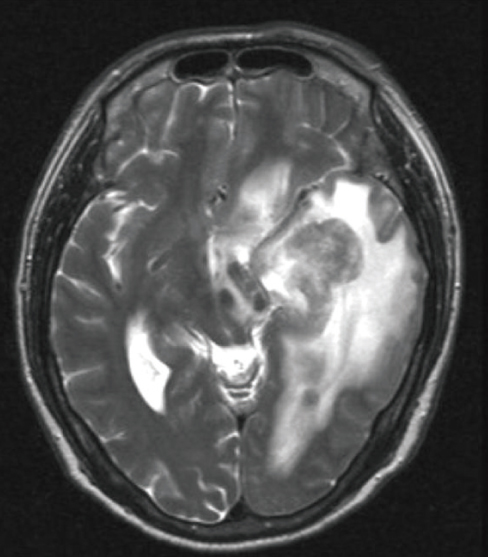Infect Chemother.
2012 Feb;44(1):17-21. 10.3947/ic.2012.44.1.17.
Multiple Opportunistic Infections and Primary Central Nervous System Lymphoma in a Patient with Idiopathic CD4+ T-lymphocytopenia
- Affiliations
-
- 1Department of Internal Medicine, Seoul National University College of Medicine, Seoul, Korea. hbkimmd@snu.ac.kr
- 2Department of Laboratory Medicine, Seoul National University College of Medicine, Seoul, Korea.
- 3Department of Internal Medicine, Seoul National University Bundang Hospital, Seongnam, Korea.
- KMID: 1782393
- DOI: http://doi.org/10.3947/ic.2012.44.1.17
Abstract
- We describe a case of idiopathic CD4+ T-lymphocytopenia (ICL) in a 59-year-old patient who presented with various opportunistic infections. The patient was diagnosed with disseminated Mycobacterium avium infection, cytomegalovirus colitis and retinitis, and esophageal candidiasis. He was successfully treated with anti-mycobacterial drugs, ganciclovir, and fluconazole, respectively. However, the patient was diagnosed with primary central nervous system lymphoma, and then died of a Trichosporon beigelii sepsis during the 2nd cycle of systemic chemotherapy.
MeSH Terms
Figure
Cited by 1 articles
-
A Case of
Trichosporon asahii Fungemia with Urinary Tract Infection as a Primary Focus
Zehwan Kim, Kyung Eun Song, Won-Kil Lee
Ann Clin Microbiol. 2015;18(2):56-59. doi: 10.5145/ACM.2015.18.2.56.
Reference
-
1. Fauci AS. CD4+ T-lymphocytopenia without HIV infection--no lights, no camera, just facts. N Engl J Med. 1993. 328:429–431.
Article2. Centers for Disease Control (CDC). Unexplained CD4+ T-lymphocyte depletion in persons without evident HIV infection--United States. MMWR Morb Mortal Wkly Rep. 1992. 41:541–545.3. Walker UA, Warnatz K. Idiopathic CD4 lymphocytopenia. Curr Opin Rheumatol. 2006. 18:389–395.
Article4. Park CM, Heo SR, Park KU, Song J, Lee JH, Lee CT, Kim EC. Isolation of nontuberculous mycobacteria using polymerase chain reaction-restriction fragment length polymorphism. Korean J Lab Med. 2006. 26:161–167.
Article5. Smith DK, Neal JJ, Holmberg SD. The Centers for Disease Control Idiopathic CD4+ T-lymphocytopenia Task Force. Unexplained opportunistic infections and CD4+ T-lymphocytopenia without HIV infection An investigation of cases in the United States. N Engl J Med. 1993. 328:373–379.
Article6. Laurence J. T-cell subsets in health, infectious disease, and idiopathic CD4+ T lymphocytopenia. Ann Intern Med. 1993. 119:55–62.
Article7. Kony SJ, Hane AA, Larouzé B, Samb A, Cissoko S, Sow PS, Sané M, Maynart M, Diouf G, Murray JF. Tuberculosis-associated severe CD4+ T-lymphocytopenia in HIV-seronegative patients from Dakar. SIDAK Research Group. J Infect. 2000. 41:167–171.
Article8. Zonios DI, Falloon J, Bennett JE, Shaw PA, Chaitt D, Baseler MW, Adelsberger JW, Metcalf JA, Polis MA, Kovacs SJ, Kovacs JA, Davey RT, Lane HC, Masur H, Sereti I. Idiopathic CD4+ lymphocytopenia: natural history and prognostic factors. Blood. 2008. 112:287–294.
Article9. DeHovitz JA, Feldman J, Landesman S. Idiopathic CD4+ Tlymphocytopenia. N Engl J Med. 1993. 329:1045–1046.
Article10. Ahn IS, Kim HG, Ryu JS, Kim L, Kwak SM, Lee HL, Yoon YH, Cho JH. A case of pulmonary cryptococcosis with non-small cell lung cancer in idiopathic CD4+T-lymphocytopenia. Yonsei Med J. 2005. 46:173–176.
Article11. Fahey JL, Taylor JM, Detels R, Hofmann B, Melmed R, Nishanian P, Giorgi JV. The prognostic value of cellular and serologic markers in infection with human immunodeficiency virus type 1. N Engl J Med. 1990. 322:166–172.
Article12. Stein DS, Korvick JA, Vermund SH. CD4+ lymphocyte cell enumeration for prediction of clinical course of human immunodeficiency virus disease: a review. J Infect Dis. 1992. 165:352–363.
Article13. Busse PJ, Cunningham-Rundles C. Primary leptomeningeal lymphoma in a patient with concomitant CD4+ lymphocytopenia. Ann Allergy Asthma Immunol. 2002. 88:339–342.
Article14. Campbell JK, Prince HM, Juneja SK, Seymour JF, Slavin M. Diffuse large cell lymphoma and t(8;22) (q24;q11) in a patient with idiopathic CD4+ T-lymphopenia. Leuk Lymphoma. 2001. 41:421–423.
Article15. Cook MA, Bareford D, Kumararatne DS. Non-Hodgkin's lymphoma: an unusual complication of idiopathic CD4+ lymphopenia. Hosp Med. 1998. 59:582.16. Quiles I, Anaut P, Cibrián F, Gainzaráin J, Vega L, Andía A. Idiopathic CD4+ T-lymphocytopenia with opportunistic infection and non-Hodgkin's lymphoma. J Intern Med. 1995. 238:183–184.
Article17. Sewell HF, MacKenzie RH, Dawson AA, Ratcliffe MA, King DJ, Bennett NB. Phenotypic abnormality of T cells in B cell non-Hodgkin's lymphoma. Dis Markers. 1990. 8:145–149.18. Beral V, Peterman T, Berkelman R, Jaffe H. AIDS-associated non-Hodgkin lymphoma. Lancet. 1991. 337:805–809.
Article19. Ayoub JP, Palmer JL, Huh Y, Cabanillas F, Younes A. Therapeutic and prognostic implications of peripheral blood lymphopenia in patients with Hodgkin's disease. Leuk Lymphoma. 1999. 34:519–527.
Article20. Hanamura I, Wakita A, Harada S, Tsuboi K, Komatsu H, Banno S, Iwaki O, Takeuchi G, Nitta M, Ueda R. Idiopathic CD4+ T-lymphocytopenia in a non-Hodgkin's lymphoma patient. Intern Med. 1997. 36:643–646.
Article
- Full Text Links
- Actions
-
Cited
- CITED
-
- Close
- Share
- Similar articles
-
- Motor Axonal Neuropathy Associated With Idiopathic CD4+ T-Lymphocytopenia
- A Case of Idiopathic CD4+ T-lymphocytopenia Associated with Autoimmune Hemolytic Anemia
- A Case of Pulmonary Cryptococcosis with Non-Small Cell Lung Cancer in Idiopathic CD4+ T-Lymphocytopenia
- A case of Idiopathic CD4+ T-Lymphocytopenia with disseminated Mycobacterium kansasii infection and Pulmonary alveolar proteinosis
- A Case of Idiopathic CD4 + T Lymphocytopenia Associated with Kaposi's Sarcoma



